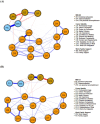Network analysis of work-family support and career identity and their associations with job burnout among primary healthcare workers: a cross-sectional study
- PMID: 40642231
- PMCID: PMC12241083
- DOI: 10.3389/fpubh.2025.1581624
Network analysis of work-family support and career identity and their associations with job burnout among primary healthcare workers: a cross-sectional study
Abstract
Objective: To explore the complex associations between job burnout, career identity, and work-family support among primary healthcare workers from a network perspective.
Methods: Data were sourced from primary healthcare institutions in China's central provinces. We used the Maslach Burnout Inventory Comprehensive Survey, a career identity scale tailored for primary healthcare workers, and the Chinese version of the Work-Family Support Questionnaire. A Gaussian network model was used to identify key factors, with "central nodes" being those that strongly influence others and "bridge nodes" connecting different parts of the network.
Results: Of the 8,135 participants surveyed, 5,120 (62.9%) reported job burnout. Compared to those with burnout, the non-burnout group scored higher in career identity, family support, and work support (54.29 vs. 49.42; 71.58 vs. 61.26; 35.03 vs. 31.20; p < 0.001). Network analysis revealed structural differences in the burnout-support-identity networks between groups after propensity score matching (M = 0.261, p < 0.001). In both groups, "understanding of role, content and requirements" were central nodes, while "work and family support" served as bridge nodes. Burnout was closely related to work support, family support, job suitability, and media criticism.
Conclusion: Targeting central and bridge nodes can help reduce job burnout among primary healthcare workers.
Keywords: career identity; job burnout; network structure; primary healthcare; propensity score matching; scientific perspective; work-family support.
Copyright © 2025 Liu, Xu, Yang, Sun, Qin and Fang.
Conflict of interest statement
The authors declare that the research was conducted in the absence of any commercial or financial relationships that could be construed as a potential conflict of interest.
Figures




Similar articles
-
A model of occupational stress to assess impact of COVID-19 on critical care and redeployed nurses: a mixed-methods study.Health Soc Care Deliv Res. 2024 Dec;13(23):1-32. doi: 10.3310/PWRT8714. Health Soc Care Deliv Res. 2024. PMID: 39708055
-
Career adaptability and job burnout of pediatric residents: the role of psychological resilience and insomnia.Med Educ Online. 2025 Dec;30(1):2525180. doi: 10.1080/10872981.2025.2525180. Epub 2025 Jun 30. Med Educ Online. 2025. PMID: 40583857 Free PMC article.
-
Correlation between job burnout, psychological status, and job satisfaction among anesthesiologists in the post-COVID-19 era: a cross-sectional study in China.Front Public Health. 2025 Jun 17;13:1555141. doi: 10.3389/fpubh.2025.1555141. eCollection 2025. Front Public Health. 2025. PMID: 40600159 Free PMC article.
-
Prevalence of burnout in health professionals working in palliative care: a systematic review.JBI Database System Rev Implement Rep. 2017 Jul;15(7):1905-1933. doi: 10.11124/JBISRIR-2016-003309. JBI Database System Rev Implement Rep. 2017. PMID: 28708752
-
Job satisfaction and burnout syndrome among intensive-care unit nurses: A systematic review and meta-analysis.Intensive Crit Care Nurs. 2024 Jun;82:103660. doi: 10.1016/j.iccn.2024.103660. Epub 2024 Feb 22. Intensive Crit Care Nurs. 2024. PMID: 38394983
References
-
- Choi M, Sempungu JK, Lee EH, Lee YH. Living longer but in poor health: healthcare system responses to ageing populations in industrialised countries based on the findings from the global burden of disease study 2019. BMC Public Health. (2024) 24:576. doi: 10.1186/s12889-024-18049-0, PMID: - DOI - PMC - PubMed
MeSH terms
LinkOut - more resources
Full Text Sources
Medical

